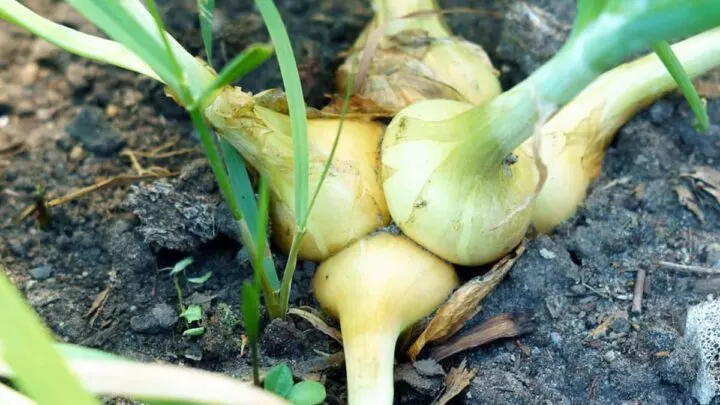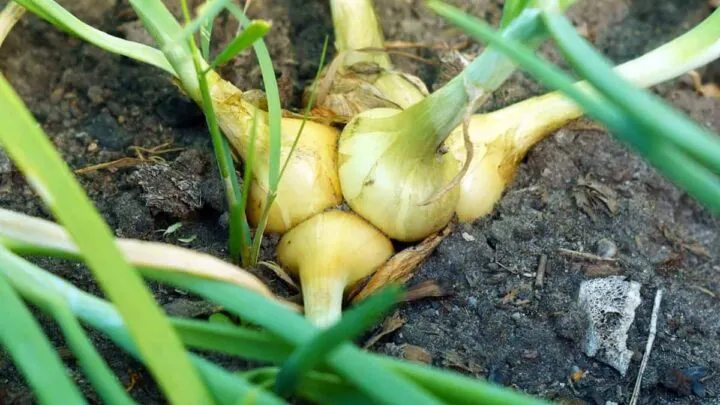Growing soil deep vegetables has always been a joy of mine. Onions in paritulcar are my favorite. They stet there in the dirt a while, and before you know it, the tops are getting long and green and you se a nice bulb forming. However, its not all rainbows, and there’s even times where I’ve seen my onion sets split before harvesting.
While onions splitting is annoying, it’s actually not that uncommon, and there’s a reason for it.
Onions typically split when they are over fertilized. Usually too much nitrogen is the cause. In addition under watering onion plants, and extreme temperatures can cause this to happen. Some onion varieties are more prone to splitting than others, and the amount of spacing between them is also a cause.
While annoying, understanding why your onions split is an important part of growing this vegetable successfully. There’s plenty of ways you can prevent onions from splitting, whether that be adjusting your watering, choosing a different variety, and controlling the environment better.
Let’s dive into the details and hopefully from my research you can learn a bit more about onion splits and how to prevent this from taking place.

Cause Of Onions Splitting
It’s never any fun to see your onion splitting, doubling; and not coming out the way it should. However, identifying the underlying cause is important so you don’t repeat this mistake across your entire garden. Below are some of the many reasons this happens.
Too Much Fertilizer
Plants that grow deep are easy to misjudge when it comes to fertilization. Onions especially, because they aren’t the fastest growing plant. Although you may see the scallions growing large, sometimes the bulb takes a while to show itself.
So, in that instance, we end up adding way too much fertilizer. This is mostly in the form of nitrogen, because we think the plant isn’t in the fruiting stage yet. Too much fertilizer will cause onions to split.
And in theory it makes sense. Fertilizing too much can accelerate the rate of growth, and as an onion matures, that can cause it to have too much of that resource to handle. It’s best to take it slow, avoid the compost teas, and instead use a slow-release, balanced fertilizer.
Poor Watering Practices
Usually when we talk about plants having watering issues, it’s more related to under watering and overwatering.
However, when it comes to onions, I want you to think about it more as uneven watering. Quite frankly, it’s easy to make this mistake with onion plants. When you overwater the area, let the soil dry, and then over-irrigate it again; this repeated process is going to cause splitting.
If your planting area is uneven, you’re going to see more of this too. Thin growing fields are also prone to this.
One thing you should do is measure out how much water you’re adding to your area every week.

Variety Of Onion
The reality is that certain onion varieties are more prone to splitting than others. This includes hybrids as well.
To help you avoid the problem in the first place, you need to select an onion type that is not likely to do this in the first place. The table below shows onion varieties known to split during the growing process:
| Onions Varieties Prone To Splitting |
|---|
| Bermuda |
| Sweet Spanish |
| Texas Grano |
| Red Onions |
Extreme Temperatures
When I say extreme temperatures, I’m talking something a good 20 degrees higher than normal. Think about those summer heat waves.
The issue with onions and temperatures is that the soil can honestly heat up so much that it causes the bulb to start splitting. Increased humidity, lack of moisture in the air, all of those things have an impact on how onions do during the growing season.
Cold temperatures have this affect too. Anything that drops below 20 degrees Fahrenheit can also result in splitting.
Onions typically like to grow in temperatures around 75 degrees Fahrenheit. Even if you wanted the seed to germinate, the temperature has to at least be above freezing. The bulb can form well even if the temperatures are a bit cooler too, no lower than 55 degrees.
Generally speaking, onions are a cool-season type of plant. So, those extreme 90 degree days in sunny Florida just aren’t ideal for them. Thankfully, even if it gets a bit hot, there’s ways you can help keep the soil cool and moist, and prevent it from drying out (more on this later!).

Spacing
For some onion varieties such as red onions, spacing them out too wide can cause splitting. This happens with some types of sweet onions too. The bulbs will simply double.
Generally, onions should have about 5 inches of space between them (a foot is better) so they can grow properly.
Avoid bunching your onions as much as possible.
Planting Too Deeply
Although onion plants need to be planted at a good depth, some gardeners (especially novice ones) end up planting them too deeply.
Planting too deeply in addition to using soil that is not loose enough will cause more than just spitting; it can cause some deformities as well.
The roots needs room to spread, and the plant needs the ability to start forming the bulb and pushing outward at just the right time.

Tips To Prevent Onions From Splitting
Most onion splitting is caused by environmental factors, but also some of our own wrongdoing as Gardners. To get the most out of your onion and to avoid the split, follow these tips:
Plant At The Correct Depth
Although onion roots need room to grow, they can sometimes grow wide; not just deep. For this reason most onions should be planted around 1 to 1/2 inches deep in the seedling transplant stage.
If your onion is being planted in a container, then this depth works as well, but it’s important to make sure that the container is at least 8 to 12 inches deep; and wide enough. If using buckets, a 5-gallon bucket is plenty large enough to grow at least two onions without running into any spacing or depth issues.
Water On A Consistent Schedule
Setting up a watering schedule is important, regardless of what crop you’re growing. For onions its even more important. The tendency is to overwater, especially in a container setting.
Set up a simple calendar, and make sure your onion gets one inch of water each week. If it’s in a container that dries out quickly, or has poor draining, you’ll need to adjust the watering by half an inch to an inch either way.
And of course, when the weather is extremely hot, its a good idea to increase that watering schedule. Your onion will usually show signs that it needs water if it starts to droop.
Apply Fertilizer At The Correct Time
Let’s face it, many gardeners don’t begin their crops on time. For that reason, it’s entirely possible that not only are you adding too much fertilizer, but you might be doing this too late in the growing process.
As a general rule, if you onion plant is already bulging, try to use a more balanced fertilizer, or one that is higher in potassium; it won’t need nearly as much nitrogen anymore.
Grow At The Right Time
Starting your onions at the correct time is really important, especially if you live in an environment where temperatures drop significantly.
Onions that are exposed to cold weather can bolt or split, especially when the diameter is quite large. For example, an onion around 3/8″ in diameter is likely to split once those temperatures drop, and it’ll happen later in the growing season.

Hi there, my name is Allie and welcome to my blog; GareningWithAllie!
Much of what you see written here is just our personal experiences with gardening. Along with the content I write here, there is also a unique collection of gardening topics covered by some of our close friends. I hope you find everything you read here to be helpful, informative, and something that can make your gardening journey the most lovely experience ever! With that said, Happy Gardening!
